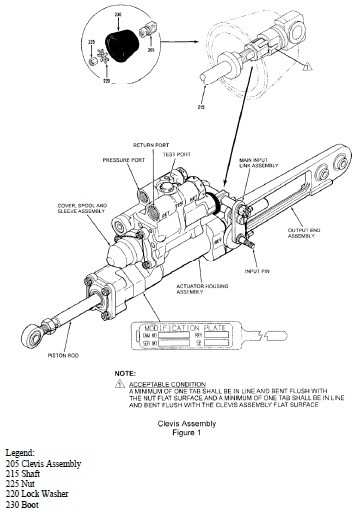Improper Lock-Washer Installation Could Lead To Servo
Malfunction
The FAA has issued an Emergency Airworthiness Directive (AD)
prompted by a report that a quality escape by a supplier has
occurred and certain hydraulic servo actuators (servo) may have a
loose nut, shaft, and clevis assembly due to improper lock-washer
installation. An investigation after an accident revealed the
clevis nut on the servo was loose. This condition, if not detected,
could lead to a malfunction of a servo in the flight control system
and subsequent loss of control of the helicopter.

The FAA has reviewed Bell Alert Service Bulletin (ASB) 407-11-96
and 427-11-35, both dated June 29, 2011, which specify the part
numbers and serial numbers of the affected servos and refer to ASB
407-05-70, Revision A, dated November 10, 2005; ASB 427-05-12,
Revision A, dated November 14, 2005; with HR Textron Service
Bulletin (SB) 41011300-67-01, Revision 2, dated November 9, 2005;
HR Textron SB 41011400-67-01, Revision 2, dated November 9, 2005;
and HR Textron SB 41011700-67-01, Revision 2, dated November 9,
2005. The ASBs also specify reidentifying the servos with a
“67-01” on the modification plate indicating the
inspection procedures were followed.
Transport Canada, the airworthiness authority for Canada,
notified the FAA that an unsafe condition may exist on these
helicopter models. Transport Canada advises that a quality escape
by a supplier has occurred, and a number of servos may have a loose
nut, shaft, and clevis assembly. Transport Canada states in its AD
that the loose connection is due to improper lock washer
installation, which is not traceable or identifiable except by
inspection. The authority also states a disconnect of the affected
parts may lead to loss of control of the helicopter. Transport
Canada classified the ASBs as mandatory and issued AD No.
CF-2011-17, dated June 30, 2011, to ensure the continued
airworthiness of these helicopters.
These helicopters have been approved by the aviation authority
of Canada and are approved for operation in the United States.
Pursuant to a bilateral agreement, Canada has notified the FAA of
the unsafe condition described in the AD. The FAA is issuing this
AD because it evaluated all information provided by Canada and
determined the unsafe condition exists and is likely to exist or
develop on other helicopters of these same type designs. Therefore,
this AD requires before further flight for certain affected servos
and within 25 hours time-in-service for certain other affected
servos, identified by a serial number, retracting the boot and
inspecting the servo as follows:
- Applying only hand pressure, determining whether the nut,
shaft, or clevis assembly turns independently. If the shaft turns
independently of the nut or the clevis assembly, before further
flight, replacing the servo with an airworthy servo.
- If the shaft does not turn independently, inspecting to
determine whether at least one tab of a lock washer is bent flush
against a flat surface of the nut and at least one tab of the lock
washer is bent flush against a flat surface of the clevis
assembly.
- If at least one lock washer tab is not aligned and bent flush
with a flat surface of the nut and at least one lock washer tab is
not aligned and bent flush with a flat surface of the clevis
assembly, before further flight, replacing the servo with an
airworthy servo.
- If any tab of the lock washer is not bent flush against either
a flat surface of the nut or clevis assembly, bending the tab flush
against a flat surface.
- Reidentifying the servo by metal-impression stamping or by
vibro etching “67.01” onto the modification plate.
- Before installing a servo with a P/N and S/N identified in this
AD, not identified by “67-01” on the modification
plate, inspecting it by following the requirements of this AD.

The actions must be done by following specified portions of the
alert service bulletins described previously.
This AD differs from Transport Canada AD in that the FAA does
not require that the servo be returned to the manufacturer. Also,
the FAA does not limit the applicability to specific
serial-numbered helicopters. The FAA has specified the inspection
requirements rather than referring to the applicable service
bulletins. The AD requires that the servo be replaced before
further flight, and the Transport Canada AD refers to the ASB,
which requires that the servo be replaced within 300 hours
time-in-service.
 Aero-News: Quote of the Day (12.11.25)
Aero-News: Quote of the Day (12.11.25) ANN's Daily Aero-Term (12.11.25): Nonradar Arrival
ANN's Daily Aero-Term (12.11.25): Nonradar Arrival Classic Aero-TV: David Uhl and the Lofty Art of Aircraft Portraiture
Classic Aero-TV: David Uhl and the Lofty Art of Aircraft Portraiture Airborne-NextGen 12.09.25: Amazon Crash, China Rocket Accident, UAV Black Hawk
Airborne-NextGen 12.09.25: Amazon Crash, China Rocket Accident, UAV Black Hawk Airborne 12.05.25: Thunderbird Ejects, Lost Air india 737, Dynon Update
Airborne 12.05.25: Thunderbird Ejects, Lost Air india 737, Dynon Update




